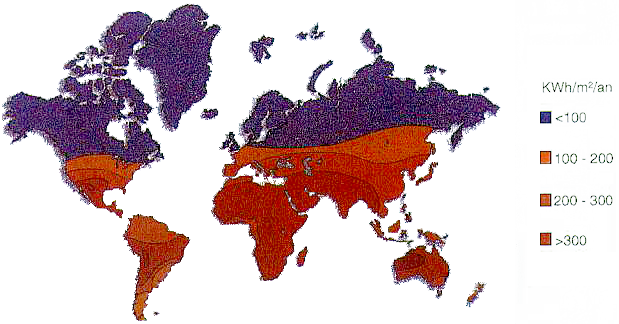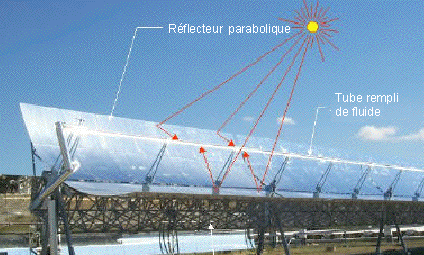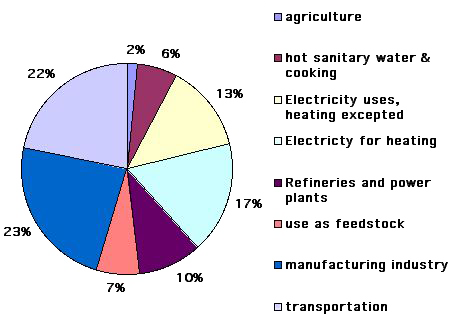The solar energy received each year by Earth is roughly equal to 10,000 times the total energy consumed by humanity. In other words, if we could only exploit 0,01% of this incoming solar energy for the profit of humankind, we could do without oil, coal, gas and uranium : there definitely lies the reason why it’s been a long time since men considered to get something significant out of sunrays. Still, it’s a long road between dreams and reality : in 2002, solar energy represented 0,04% of the global energy consumption in the world. Is it to say that we will never be able to do better ? In order to enable everyone to get to one’s own conclusions, here are a couple of figures related to this energy.
Could we produce all french electricity with only solar panels?
In 2002, the french electricity production amounted to 550 TW.h (1 TW.h = 1 billion kW.h).
The annual production of a photovoltaic panel is 100 kWh per m², at least for the largest part of Europe (below).

Annual production potential of photovoltaic electricity depending on the zone.
One will notice :
- that a majority of developped countries are in zones equally or better insulated than France, that I use as a reference for the calculation below (northern Europe du Nord : Netherlands, United Kingdom, Germany, etc, are not much below 100 kWh/m²/year ; only scandinavian countries are much below that level),
- that all “developping countries” are better insulated than France
Source : Commissariat Général du Plan.
If we only consider gross outputs, we should cover 5,000,000,000 m2 to get the same amout of electricity, that is 5.000 km2. It is indeed a lot in absolute figures, but if we compare it to the total surface of France (which is over 500.000 km2), we see that it represents only 1% of the metropolitan surface. And, most of all, the surface that is already built (excluding roads) amounts to 10.000 km² (see figures on urbanization).
By covering only half of the existing roof surface with solar panels, we could thus produce something that is of the same magnitude than our present electricity consumption, that is something which is between 20 and 40% of our total energy consumption, depending on the way we calculate it (see explanations here).
Furthermore, the total electricity consumption in France in 2002 was not 550 TWh, but rather 420 TWh : 10% of the production is lost in the grid during transport and distribution, and 15% is exported. As photovoltaic production is generally made close to the place where electricity will be used, we do not have to take the transportation losses into account if this way to produce electricity becomes widespread. It would also seem curious to produce electricity this way to export it, hence it is rather for the 420 TWh of domestic consumption that we should make our calculations, and that requires to cover “only” 0,8% of the country with panels.
But if such a way to produce electricity became widespread, we would have to store a significant fraction of the production. Indeed, there is sunlight only during the day (it’s even the definition of what a day is !), when an important part of the electricity is consumed at night : consumption of factories that operate all night, of fridges and freezers, of part of domestic electronics, of lighting, heating and/or air con….). Furthermore, there is more light in the summer, when the electricity consumption, in most european countries, peaks in the winter.
And that’s where problems start, because electricity is not easy to store. Let’s see, for example, what it would mean if we stored it using hydrogen, this hydrogen being produced by electrolysis with the electricity obtained from the solar panel:
| Step | Approximative yield* |
|---|---|
| Electrolysis to produce hydrogen | 80% |
| Storing hydrogen in a tank under a 700 atmosphere pressure | 80% |
| Liquefaction of hydrogen | 50% |
| Cogeneration in a fuell cell | 80% ? |
| Producing back electricity from hydrogen in a fuel cell | 50% |
| Global efficiency of a chain [solar panel → electrolysis → compression → fuel cell] | 30% |
*An approximate yield of 80% means that 20% of the initial hydrogen is consumed – or its energy equivalent – to compress the remaining 80%.
Hence we see that it is rather 2,5% that 0,8% of the country that we should cover with solar panels to take into acount the losses due to storage.
Then, if we want to know the real net output, we must also deduce the initial energy investment which is necessary to manufacture the solar panel, and the associated storage device. Producing a solar panel consumes today the equivalent of 5 years of production of the said panel. Then we must also take into account the energy spent to manufacture the battery, which is the only available storage device today, and the result commonly given is that it takes roughly 10 years of production to reimburse the initial energy investment of the total “panel + battery”.
As a panel has a 25 year life usage, we see that about half the gross production of the whole device goes to the initial energy debt linked to the production of the device. In other terms, if we want to take into account the energy spending required to manufacture the device, it’s rather 5% of France that we should cover with panels.
If we cannot, with such a percentage, consider as possible to produce all our electricity with solar panels, the above calculation still does not forbid to consider that it should be possible to get much more out of these panels than what we presently get.
But solar panel production is probably going to benefit from future technological breakthrough. For example, with new production technologies called “thin layer” (because the semi-conductor is deposited as a very thin layer on a plastic substract), the initial energy debt would represent only 1 to 2 years of the future panel output, or even less. This would remove a first significant obstacle to envision a significant wpreading of this way to produce electricity. Let’s recall that the “initial energy debt” for liquid hydrocarbons is around 20% : for every litre of oil that we consume (under the form of diesel oil, petrol, etc) we have to burn teh equivalent of 20 cl to extract, transport and refine it.
However, for the time being, it’s storing electricity that remains the weak point. We could of course mass produce electricity with panels connected to the grid, but if the name of the game is to get rid of fossil fuels, or to cut rapidly the greenhouse gases emissions, we’d better use hydroelectric or nuclear electricity (see below). Furthermore, as solar production is intermittent, it is not possible to conceive a system “100% photovoltaïc solar” without any storage device or complementary production means. And when the intermittence is very pronounced (which is the case with photovoltaïc solar : all production during daylight, nothing at night) the complementary production means are gas or coal, which is not optimum to meet the two above mentionned objectives !
If photovoltaïc solar systems are considered mainly for self consumption, it is necessary to store : with the available technologies (lead-acid batteries), we should have a couple tonnes of batteries in every house (see calculations on this page), what would require considerable amounts of resources. Putting solar panels everywhere today remains difficult to conceive without a significant improvement of storage devices, not to mention that the average power delivered by a set of batteries is much better suited to domestic applications than to industrial ones (in France the industry consumes 50% of the total, roughly). And regarding storage, alas, breakthrough is less in sight than for production.
Is photovoltaïc solar a good idea to mitigate global warming?
Well, it all depends on the way electricity is produced in the country.
| Energy source | CO2 emissions (g/kWh) |
|---|---|
| Coal | 800 à 1050 suivant technologie |
| Gas turbines | 430 |
| Nuclear | 6 |
| Hydraulic | 4 |
| Wood | 1500 without replantation |
| Photovoltaic | 60 à 150 |
| Wind generation | 3 à 22 |
Electricity generation : CO2 emissions in g/ kWh (life cycle analysis).
Source : EDF, quoted in La Jaune et La Rouge, May 2000
If photovoltaïc solar is definitely much better than electricity produced with coal or gas fired power plants, it remains a higher emitter per kWh than the two real “CO2 free” modes which are hydroelectric and nuclear (wind power is totally marginal and bound to remain so for a while). In France, for example, replacing nuclear power plants by photovoltaïc solar would not lead to a savings on greenhouse gases emissions, on the opposite.
But it is perfectly defendable to use such a way to produce electricity to help “pulling out from oil”, or rather “pulling out of coal”.
Is it economical?
The average price of the kWh (between 30 and 60 cents of Euros depending on the sources ; without taking storage into account) is about 4 times higher than the price of domestic electricity in France. But :
- if electricity generated out of coal, gas or oil had to support a carbon tax, the price of the kWh (just after production) could jump to this much,
- for the last 20 years, the price per kWh has decreased accordingly with the installed power, and the technological breaktrough in sight make legitimate to consider that this decrease will go on for a while ; a division by 3 of the price per kWh around 2020 is considered likely by experts. Taking into account the externalities of fossil generated electricity, photovoltaïc solar could therefore become competitive with “fossil electricity” around 2010 (but will not be compared to nuclear, which is another good idea for the future).
This “quick calculation” does not pretend to highlight an obvious solution to the double threat posed by the greenhouse effect and the fossil fuel depletion. But it underlines that the magnitude of the supply still allows to consider that “someday” (a day not too remote, preferably, if we want to avoid big trouble) we might get a significant energy resource for our needs (that could be strongly diminished).
Is it necessary to use photovoltaïc panels to generate electricity out of sun rays?
There are many other ways to generate electricity out of sunrays :
- it is possible to heat a fluid by concentrating the sinlight on it with parabolic reflectors, the heated fluid then being used to generate vapour that will in turn generate electricity:

Basic principle of concentration solar : a parabolic reflector (left white arrow) concentrates sunrays on a tube carrying a fluid (right white arrow).
The fluid then heats a reservoir (now shown on the picture) to several hundred °C ; this reservoir then serves as a heat source to generate vapour then electricity.
The reservoir is hot enough and insulated well enough so that the plant can continue to generate electricity overnight.
The surface required to produce a TWh is probably twice lower than for photovoltaïc solar. Such plants are already economically competitve in highly insulated zones (close to deserts for example). Instead of exporting oil, some tropical countries could export electricity ! It is true that it would not solve them problem of the energetic independance of France, but we would partly solve that of climate change, which is not without interest….
It is also possible to concentrate the sunrays with a forest of plane reflectors, fixed on the ground, that converge the light to a tower installed in the middle.
- It is possible to built a high tower painted black, in which the air in inspired at the bottom, heated in the black – hence hot – tube of the tower, and rejected hot at the top. This generates a permanent ascendant air flux in which windmills are placed (Australians have built such a prototype).
Is it possible to do “something else” than electricity with solar energy ?
There is another way to use solar energy, which is technogically mature enough to be widely used : it’s to get heat out of the sunrays. In this case, instead of putting on the roof a panel designed to produce electricity, the idea is to put a panel that produces hot water that will be used for sanitary uses, or for heating. The yield of such a device is three times better than that of a phtovoltaïc panel (that means that when producing hot water, a panel captures 30% to 40% of the incident solar energy). In favourable conditions, such a device allows to save about 50% on the energy spending that corresponds to heating and sanitary hot water.
As these two items (heating and sanitary hot water) represent more than 30% of the total energy consumption in France (including domestic and office use), a wide use of thermal solar would allow to save 10 to 15% of our total energy consumption (to give an element of comparison, in 1999 the Danes got 1,5% of their total energy consumption with wind power). A “massive” call on thermal solar, coupled with an important insulation of ancient houses and offices, might lead to a rough 25% saving on the national total.

Breakdown of the final energy demand in France for 1999.
Source : Observatoire de l’énergie
The conclusion is therefore that thermal solar has a true potential to contribute to savings on fossil fuel consumption without a significant loss on comfort. Furthermore, heat storage has not been much investigated in our modern societies (much more investigations have been made on electricity storage), and if we could manufacture a well performing seasonal storage device (for example with well insulated underground reservoirs of salted water with stones), we could probably get much more out of this source.
And a vast plan aiming at getting all houses well insulated and as much heated with thermal solar as possible would be a very good thing for employement : today 2 million people buy a new car each year, worth a little less than 15.000 euros on average. If “pulling out of fossil fuels” became the first priority of our economy, one can imagine that half a million to one million households rather buy a complete renovation of their lodging, with a thermal solar heating among other things, so that all lodging is renovated in 40 years. If the unitary cost of every operation is about 15.000 euros, it would create an economic activity worth 30 billion euros per year in France, benefiting for the most part to plumbers, bricklayers, and small industrial companies.
And even hydrogen…
With solar power plants (such as concentration solar plants, see above), one can also consider to produce hydrogen, through water thermolysis (it is then a totally renewable resource) or the thermolysis of a mixture of water vapour and methane (this way to produce hydrogen does not avoid greenhouse gases emissions, but still much less than producing hydrogen out of methane cracking). However, as the only places where a large scale hydrogen production out of solar energy are tropical deserts, we would then be faced to the problem of transportation of hydrogen over long distances, which is not obvious to solve.
Indeed, the amount of energy that must be spent to store and transport a gas is roughly the same whatever the gas is. It means, in concrete terms, that it takes the same amount of energy to transport and store 1 cubit metre of gaz, whether it is methane or hydrogen, when the energy freed by combustion is much higher, per volume unit, for methane than for hydrogen (there is a 3 à 1 ratio: 10 kWh/m³ for methane, 3,3 kWh/m³ for hydrogen).
This means that the efficiency of storage and long distance transportation of hydrogen is probably bound to remain forever “not very good” for physical reasons. Still, this way of producing hydrogen might be very interesting for well insulated countries, that are quite numerous !
And biomass?
At last, the sun enables to growth of trees… that therefore constitute a stock of solar energy. Is it interesting to use it to produce electricity ? The gross energy output per hectare is about 5 tonnes oil equivalent in the bast cases (in european countries), that is about 60 MWh (1 tonne oil equivalent = 42 billion joules = 11600 kWh). This amount corresponds to the annual growth of the wood, of course, not to what would be obtained if all the wood was logged and burnt (but then it is not renewabel at all !). Knowing that the efficiency of a power plant is 40% to 50%, it requires something like 500 km² of forests to produce 1 TWh (that is 1 billion kWh).
If the anual electricity production in France (about 550 TWh) was totally made out of wood, we would need for this purpose about….50% to 100% of the surface of the country ! We find here figures that are as “irrealistic” as those obtained for biofuels.
But the potential of wood for direct heat production is much higher. As the enery spending for heating is about 0,75 toe (1 tonne oil equivalent – or toe – is worth 11,600 kWh) per French person, and as the efficiency of a a good central heating system is 60%, heating the whole country on wood would require 120.000 km² of forest land (20% to 25% of the country). We could do so, providing we accepted not to have any more construction wood, or not more meat (each usage requires 20% of the surface of the country).